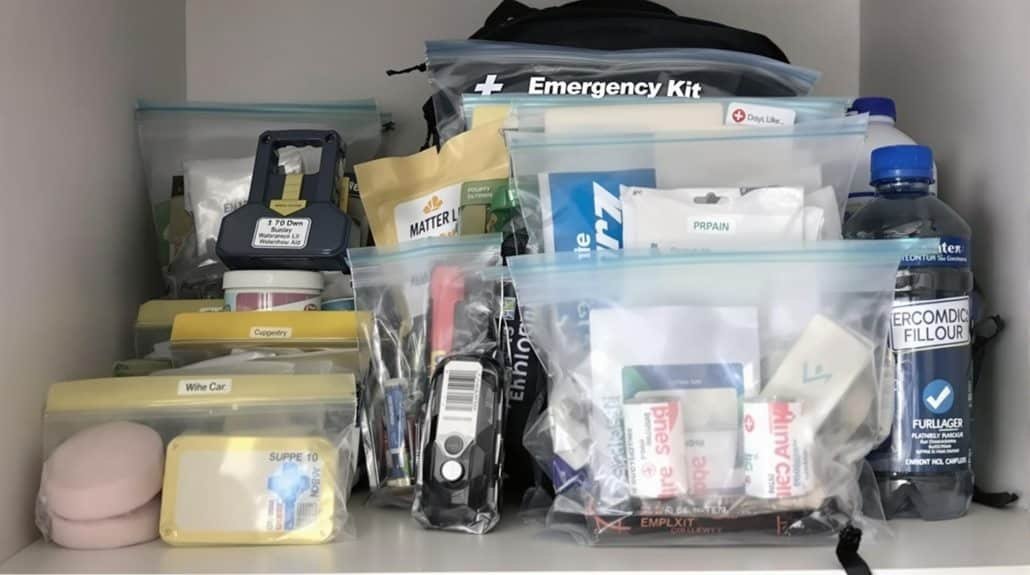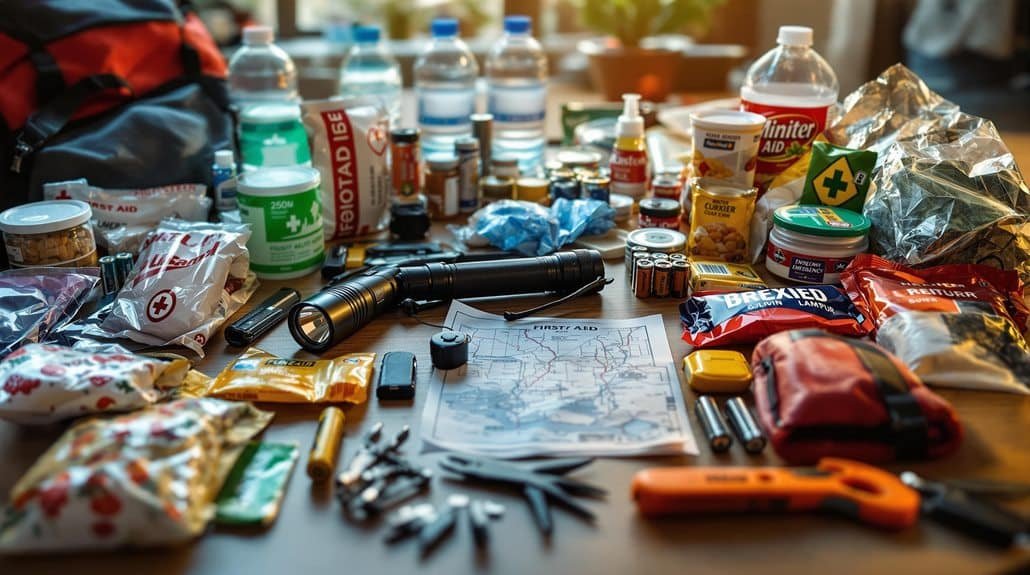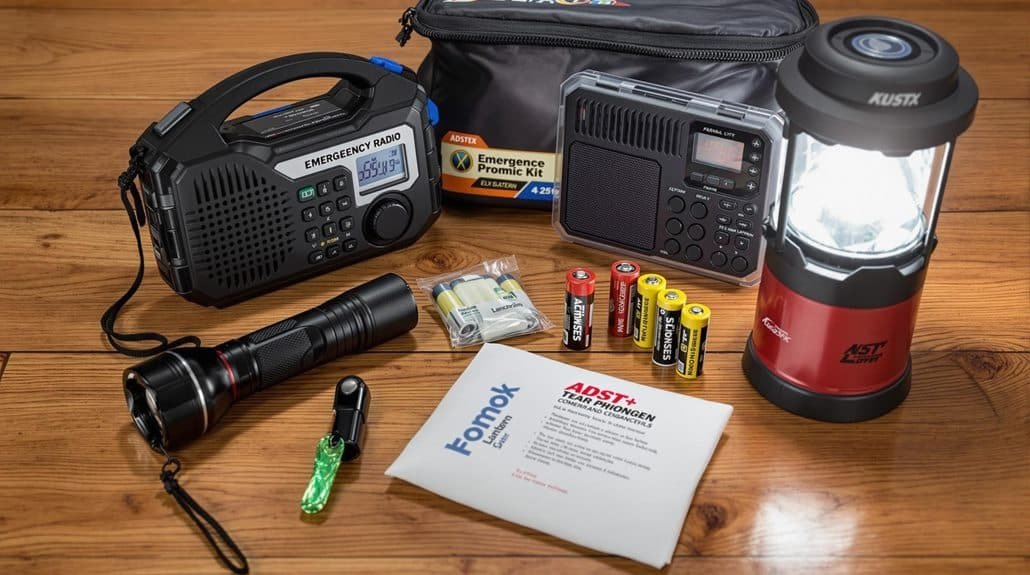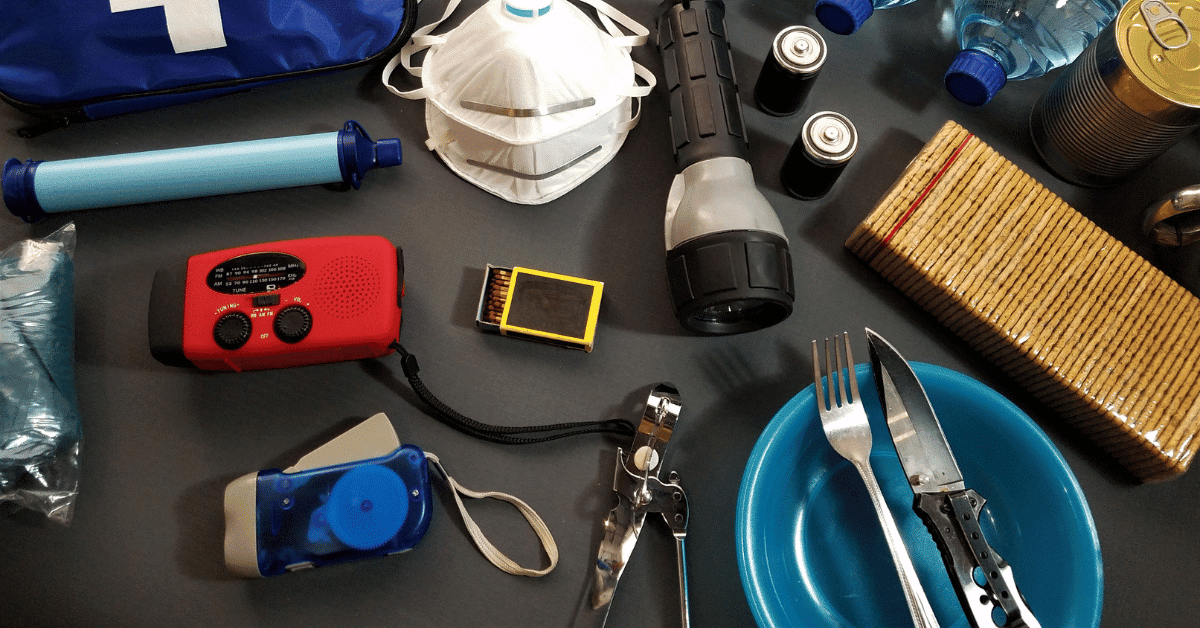You’ve probably thought about what you’d need in an emergency, but have you really considered what makes the emergency kit essentials effective or not? It’s not just about throwing a few items together and hoping for the best. An organized, well-thought-out kit could be the difference between comfort and chaos when disaster strikes. From basic supplies like water and food to often-overlooked essentials like a crank radio and personal documents, each item serves a purpose. But how do you guarantee your kit is truly prepared for any situation? There’s more to this than meets the eye.
Key Takeaways
- Ensure your kit includes water, non-perishable food, and a flashlight for basic survival needs.
- Pack a first-aid kit and medications to address medical emergencies and personal health requirements.
- Incorporate communication tools like a crank radio and portable phone charger for staying informed and connected.
- Add essential tools such as batteries, a whistle, and a solar-powered flashlight for safety and visibility.
- Rotate and check supplies regularly to keep them fresh and functional.
Basic Disaster Supplies
Having a well-stocked basic disaster supplies kit can greatly enhance your preparedness for emergencies. Imagine the freedom that comes with knowing you’re ready for the unexpected. To build an emergency kit, focus on the essentials that empower you to face any challenge. Start with a detailed kit checklist that includes items like water, non-perishable foodMake sure you have a flashlight, extra batteries, and important family documents in your emergency kit. These emergency supplies are important for maintaining your independence during a crisis.
Additionally, consider incorporating basic survival techniques that are covered in comprehensive resources for emergency readiness.
Your emergency supply kit should also contain a first-aid kit, batteries, and a crank radio, ensuring you stay informed and connected. Preparing for the unknown means thinking ahead, so don’t forget to include personal items like medications and extra clothing. Each item in your disaster supplies kit plays a crucial role in your emergency preparedness, offering peace of mind when you need it most.
Organizing Your Kit
Efficiently organizing your emergency kit can make a significant difference when every second counts. A well-organized kit guarantees that you can quickly access the essentials during a disaster, keeping you and your loved ones prepared. Begin by categorizing your supplies into logical groups, such as food, water, medical items, and tools. This makes locating what you need in an emergency straightforward and stress-free. Consider any special needs while planning your kit, ensuring that specific medications or mobility aids are easily accessible. Additionally, it’s crucial to educate yourself and others on using the items in your kit effectively, as understanding your equipment can greatly enhance your preparedness.
To help you organize effectively, follow these steps:
- Create a detailed inventory: List every item in your kit, checking it regularly to maintain up-to-date supplies.
- Label each compartment: Use clear labels for each section of your kit to simplify the process of finding items in a hurry and to record what you have.
- Prioritize easy access: Place the most frequently needed essentials, like a flashlight or first aid kit, at the top or in side pockets.
- Develop a rotation plan: Regularly rotate perishable items, such as food and batteries, to ensure everything remains functional and fresh.
Kit Storage Tips

Storing your emergency kit properly guarantees it’s ready to go when you need it most. Kit storage is an essential aspect of emergency preparedness, securing that your kit essentials are accessible and intact. Start by selecting strategic storage locations that align with your evacuation routes, such as your home, car, and workplace. This approach secures you’re never far from your emergency supplies.
Effective kit organization makes a difference. Use airtight containers to keep items safe from moisture and pests. Label each container for easy identification, considering the unique needs of each family member. For example, if someone requires specific medications or dietary items, make sure those are easily reachable.
Regular kit maintenance is necessary. Check expiration dates on food and medication regularly, and refresh supplies as needed.
Include a flashlight and batteries, and verify any electronic devices are charged. Integrate your emergency kit with essential supplies and important family documents to stay prepared.
Emergency Preparedness Plan

While a well-organized kit is vital, having a solid emergency preparedness plan guarantees you know what to do when disaster strikes. Your kit should include essential items, but don’t stop there. Think beyond just what’s in your portable container. Regularly update kits to confirm they remain effective, and remember to designate a place for your home kit. Practice your plan so it becomes second nature, and stay informed about local hazards to be ready for any situation. Additionally, empowerment through education can enhance your skills and confidence, making your preparedness plan more sturdy. To build a sturdy emergency preparedness plan, follow these steps:
- Create a communication plan. Confirm everyone in your household knows how to contact each other and where to meet in emergencies.
- Prepare emergency supplies in your car. Include food, water, and medicines to cover unexpected situations while on the road.
- Keep additional items handy. Consider essentials like cash, important documents, and a basic first-aid kit. These could be lifesavers when traditional systems are unavailable.
- Know your evacuation routes. Familiarize yourself with local escape paths to confirm a swift, safe exit if needed.
Special Needs Considerations
Every family’s emergency preparedness plan should account for special needs to guarantee no one is left vulnerable during a disaster. Identifying unique needs of your family members is crucial. You should make sure that hearing aids, batteries, and mobility aids are readily available. Keep a well-organized list of medical providers to quickly access essential information when needed. This list becomes invaluable should you need to contact medical professionals for assistance.
Consider dietary needs as well. Stock foods that meet specific requirements, ensuring everyone’s health remains a priority.
Additionally, make a plan for pets and service animals. Their well-being is just as important, and having a clear strategy will ensure they’re safe and secure. Make sure you have their food, medications, and any necessary items ready.
It’s essential to communicate with medical providers about any specific needs you might face during an emergency. Their guidance can help you make informed decisions when building your emergency kit. By factoring in these special needs considerations, you’re not only guaranteeing the safety of your loved ones but also embracing a sense of freedom and preparedness, knowing that you’ve covered all possibilities.
Additional Supplies to Pack
When assembling your emergency kit, consider adding additional supplies that could prove invaluable during a crisis. While the basic necessities are important, enhancing your kit with certain items, such as important family documents, can offer peace of mind and readiness for unexpected situations. Start by making sure you have prescription medications for all family members, as access to pharmacies might be limited during an emergency. Evaluate the needs of your pet and include any specific medication or supplies they may require.
A portable or handheld radio and flashlight are essential for staying informed and safely moving in the dark. Remember to include spare batteries to keep these devices operational when you need them most. Protect your documents and devices from water damage by using water-resistant containers or bags.
Here’s a list of additional supplies you should consider packing:
- Water-resistant storage bags for important documents and electronics.
- Battery-powered radio to stay updated on emergency broadcasts.
- Spare batteries to make sure your devices remain functional.
- Pet supplies, including food, water, and any necessary medications.
Food and Water Essentials
After verifying your emergency kit is stocked with necessary supplies, it’s important to focus on the cornerstones of survival: food and water. You should store enough water for at least three days, calculating one gallon per person, per day. Keeping track of expiration dates is vital, so rotate your water and other supplies regularly.
Non-perishable food items, like canned goods and dry mixes, should also be updated annually to guarantee freshness.
You can’t overlook prescription and non-prescription medications. Store extra doses of essential medications, and include basics like antacids or laxatives, and anti-diarrhea medication, as these can be invaluable during a crisis. Be mindful of family members with unique dietary needs, such as baby formula or items for individuals requiring specific nutrition.
For those with infants, pack enough diapers and wipes to last several days. Remember, freedom comes from being prepared for any situation without being restrained by unmet needs. By maintaining a well-stocked and regularly updated emergency kit, you free yourself from the limitations that could arise in emergencies. This level of preparedness empowers you to face unexpected challenges with confidence and resilience.
Communication and Lighting Tools

In the midst of an emergency, having – alongside your other essentials – reliable communication and lighting tools can make all the difference. When your world is turned upside down, being able to communicate and see clearly is pivotal. Your emergency kit should include essential communication devices to make sure you’re never cut off from essential information or assistance. An effective communication plan keeps you connected with loved ones and informed about unfolding events.
Consider adding these items to your emergency supplies:
- Battery-powered or hand-crank radio: Stay informed about weather updates and emergency announcements.
- Solar-powered or hand-crank flashlight: Reliable emergency lighting makes sure you’re not left in darkness.
- Whistle: A simple, effective tool for emergency communication, helping to signal for help when needed.
- Portable phone charger: Keep your communication tools running, ensuring you can reach out when necessary.
Each of these emergency kit essentials plays a key role in maintaining your autonomy and safety during unexpected situations.
Emergency preparedness isn’t just about physical supplies; it’s about equipping yourself with the right tools to navigate challenges confidently. Embrace the freedom that comes with being prepared, knowing you’ve done everything possible to safeguard your future.
Frequently Asked Questions
How Often Should I Check for Updates on Emergency Preparedness Guidelines?
You should check for updates on emergency preparedness guidelines every six months. Stay informed and adaptable, empowering yourself to handle unexpected situations confidently. Regular updates guarantee you’re ready to face new challenges and embrace freedom from fear.
What Are the Best Ways to Maintain Kit Items During Extreme Weather Conditions?
Keep your kit items dry and secure by using waterproof containers. Store them in a stable, cool place. Rotate perishables regularly. Protect electronics with dry bags. Stay proactive, ensuring you’re always ready for life’s unpredictable moments.
How Can I Involve Children in Emergency Kit Preparation?
Don’t underestimate kids’ abilities; they’re enthusiastic to help. Let them choose comfort items, explain item purposes, and practice emergency plans. Empowering them fosters confidence, ensuring they’re prepared and self-reliant during emergencies, granting them a sense of freedom.
Are There Any Mobile Apps Recommended for Managing Emergency Kits?
You can use mobile apps like Ready.gov or FEMA to manage emergency kits. These apps offer reminders to update items, track expiration dates, and provide checklists. Embrace technology to empower your preparedness journey and stay ready for anything.
What Steps Should I Take to Ensure My Kit Is Accessible During Power Outages?
Explore the theory that preparedness liberates you. Keep your kit in a known, easily reachable spot. Use glow-in-the-dark tape for visibility. Confirm it’s not hidden by furniture and regularly check access paths are free from obstacles.
Conclusion
By carefully assembling your emergency kit, you’re crafting a lifeline, a beacon of resilience in uncertain times. Each item, from water to a crank radio, symbolizes a thread in the safety net you’re weaving for yourself and your loved ones. Organize your essentials with precision, store them strategically, and incorporate personal needs, ensuring readiness for any storm that may come. Your kit isn’t just supplies; it’s a reflection of your foresight and preparedness.

